Recombinant Isfahan Virus and Vesicular Stomatitis Virus Vaccine Vectors Provide Durable, Multivalent, Single-Dose Protection against Lethal Alphavirus Challenge
- PMID: 28148802
- PMCID: PMC5375677
- DOI: 10.1128/JVI.01729-16
Recombinant Isfahan Virus and Vesicular Stomatitis Virus Vaccine Vectors Provide Durable, Multivalent, Single-Dose Protection against Lethal Alphavirus Challenge
Abstract
The demonstrated clinical efficacy of a recombinant vesicular stomatitis virus (rVSV) vaccine vector has stimulated the investigation of additional serologically distinct Vesiculovirus vectors as therapeutic and/or prophylactic vaccine vectors to combat emerging viral diseases. Among these viral threats are the encephalitic alphaviruses Venezuelan equine encephalitis virus (VEEV) and Eastern equine encephalitis virus (EEEV), which have demonstrated potential for natural disease outbreaks, yet no licensed vaccines are available in the event of an epidemic. Here we report the rescue of recombinant Isfahan virus (rISFV) from genomic cDNA as a potential new vaccine vector platform. The rISFV genome was modified to attenuate virulence and express the VEEV and EEEV E2/E1 surface glycoproteins as vaccine antigens. A single dose of the rISFV vaccine vectors elicited neutralizing antibody responses and protected mice from lethal VEEV and EEEV challenges at 1 month postvaccination as well as lethal VEEV challenge at 8 months postvaccination. A mixture of rISFV vectors expressing the VEEV and EEEV E2/E1 glycoproteins also provided durable, single-dose protection from lethal VEEV and EEEV challenges, demonstrating the potential for a multivalent vaccine formulation. These findings were paralleled in studies with an attenuated form of rVSV expressing the VEEV E2/E1 glycoproteins. Both the rVSV and rISFV vectors were attenuated by using an approach that has demonstrated safety in human trials of an rVSV/HIV-1 vaccine. Vaccines based on either of these vaccine vector platforms may present a safe and effective approach to prevent alphavirus-induced disease in humans.IMPORTANCE This work introduces rISFV as a novel vaccine vector platform that is serologically distinct and phylogenetically distant from VSV. The rISFV vector has been attenuated by an approach used for an rVSV vector that has demonstrated safety in clinical studies. The vaccine potential of the rISFV vector was investigated in a well-established alphavirus disease model. The findings indicate the feasibility of producing a safe, efficacious, multivalent vaccine against the encephalitic alphaviruses VEEV and EEEV, both of which can cause fatal disease. This work also demonstrates the efficacy of an attenuated rVSV vector that has already demonstrated safety and immunogenicity in multiple HIV-1 phase I clinical studies. The absence of serological cross-reactivity between rVSV and rISFV and their phylogenetic divergence within the Vesiculovirus genus indicate potential for two stand-alone vaccine vector platforms that could be used to target multiple bacterial and/or viral agents in successive immunization campaigns or as heterologous prime-boost agents.
Keywords: Eastern equine encephalitis virus; Isfahan virus; Venezuelan equine encephalitis virus; vesicular stomatitis virus.
Copyright © 2017 American Society for Microbiology.
Figures




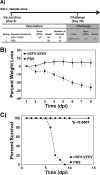
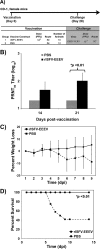
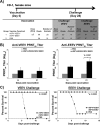
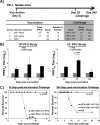
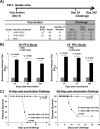
Similar articles
-
Novel Insect-Specific Eilat Virus-Based Chimeric Vaccine Candidates Provide Durable, Mono- and Multivalent, Single-Dose Protection against Lethal Alphavirus Challenge.J Virol. 2018 Jan 30;92(4):e01274-17. doi: 10.1128/JVI.01274-17. Print 2018 Feb 15. J Virol. 2018. PMID: 29187545 Free PMC article.
-
A Monovalent and Trivalent MVA-Based Vaccine Completely Protects Mice Against Lethal Venezuelan, Western, and Eastern Equine Encephalitis Virus Aerosol Challenge.Front Immunol. 2021 Jan 19;11:598847. doi: 10.3389/fimmu.2020.598847. eCollection 2020. Front Immunol. 2021. PMID: 33542715 Free PMC article.
-
A Multiagent Alphavirus DNA Vaccine Delivered by Intramuscular Electroporation Elicits Robust and Durable Virus-Specific Immune Responses in Mice and Rabbits and Completely Protects Mice against Lethal Venezuelan, Western, and Eastern Equine Encephalitis Virus Aerosol Challenges.J Immunol Res. 2018 Jun 3;2018:8521060. doi: 10.1155/2018/8521060. eCollection 2018. J Immunol Res. 2018. PMID: 29967804 Free PMC article.
-
Live virus vaccines based on a vesicular stomatitis virus (VSV) backbone: Standardized template with key considerations for a risk/benefit assessment.Vaccine. 2016 Dec 12;34(51):6597-6609. doi: 10.1016/j.vaccine.2016.06.071. Epub 2016 Jul 6. Vaccine. 2016. PMID: 27395563 Free PMC article. Review.
-
[The vaccines based on the replicon of the venezuelan equine encephalomyelitis virus against viral hemorrhagic fevers].Vopr Virusol. 2015;60(3):14-8. Vopr Virusol. 2015. PMID: 26281301 Review. Russian.
Cited by
-
Insights into Antibody-Mediated Alphavirus Immunity and Vaccine Development Landscape.Microorganisms. 2021 Apr 22;9(5):899. doi: 10.3390/microorganisms9050899. Microorganisms. 2021. PMID: 33922370 Free PMC article. Review.
-
rVSVΔG-ZEBOV-GP (also designated V920) recombinant vesicular stomatitis virus pseudotyped with Ebola Zaire Glycoprotein: Standardized template with key considerations for a risk/benefit assessment.Vaccine X. 2019 Jan 29;1:100009. doi: 10.1016/j.jvacx.2019.100009. eCollection 2019 Apr 11. Vaccine X. 2019. PMID: 31384731 Free PMC article.
-
Clinical and Immunological Effects of p53-Targeting Vaccines.Front Cell Dev Biol. 2021 Nov 3;9:762796. doi: 10.3389/fcell.2021.762796. eCollection 2021. Front Cell Dev Biol. 2021. PMID: 34805170 Free PMC article. Review.
-
Novel Insect-Specific Eilat Virus-Based Chimeric Vaccine Candidates Provide Durable, Mono- and Multivalent, Single-Dose Protection against Lethal Alphavirus Challenge.J Virol. 2018 Jan 30;92(4):e01274-17. doi: 10.1128/JVI.01274-17. Print 2018 Feb 15. J Virol. 2018. PMID: 29187545 Free PMC article.
-
Self-replicating vehicles based on negative strand RNA viruses.Cancer Gene Ther. 2023 Jun;30(6):771-784. doi: 10.1038/s41417-022-00436-7. Epub 2022 Feb 15. Cancer Gene Ther. 2023. PMID: 35169298 Free PMC article. Review.
References
-
- Knipe DM, Howley PM, Cohen JI, Griffin DE, Lamb RA, Martin MA, Racaniello VR, Roizman B (ed). 2013. Fields virology, 6th ed, vol I Lippincott Williams & Wilkins, Philadelphia, PA.
-
- Tesh RB, Travassos Da Rosa AP, Travassos Da Rosa JS. 1983. Antigenic relationship among rhabdoviruses infecting terrestrial vertebrates. J Gen Virol 64(Part 1):169–176. - PubMed
-
- Tesh R, Saidi S, Javadian E, Loh P, Nadim A. 1977. Isfahan virus, a new vesiculovirus infecting humans, gerbils, and sandflies in Iran. Am J Trop Med Hyg 26:299–306. - PubMed
-
- Gaidamovich S, Obukhova VR, Sveshnikova NA, Cherednichenko IUN, Kostiukov MA. 1978. Natural foci of viruses borne by Phlebotomus papatasi in the USSR according to a serologic study of the population. Vopr Virusol 1978:556–560. (In Russian.) - PubMed
-
- Gaidamovich S, Altukhova LM, Obukhova VR, Ponirovskii EN, Sadykov VG. 1980. Isolation of the Isfahan virus in Turkmenia. Vopr Virusol 1980:618–620. (In Russian.) - PubMed
Publication types
MeSH terms
Substances
Grants and funding
LinkOut - more resources
Full Text Sources
Other Literature Sources

